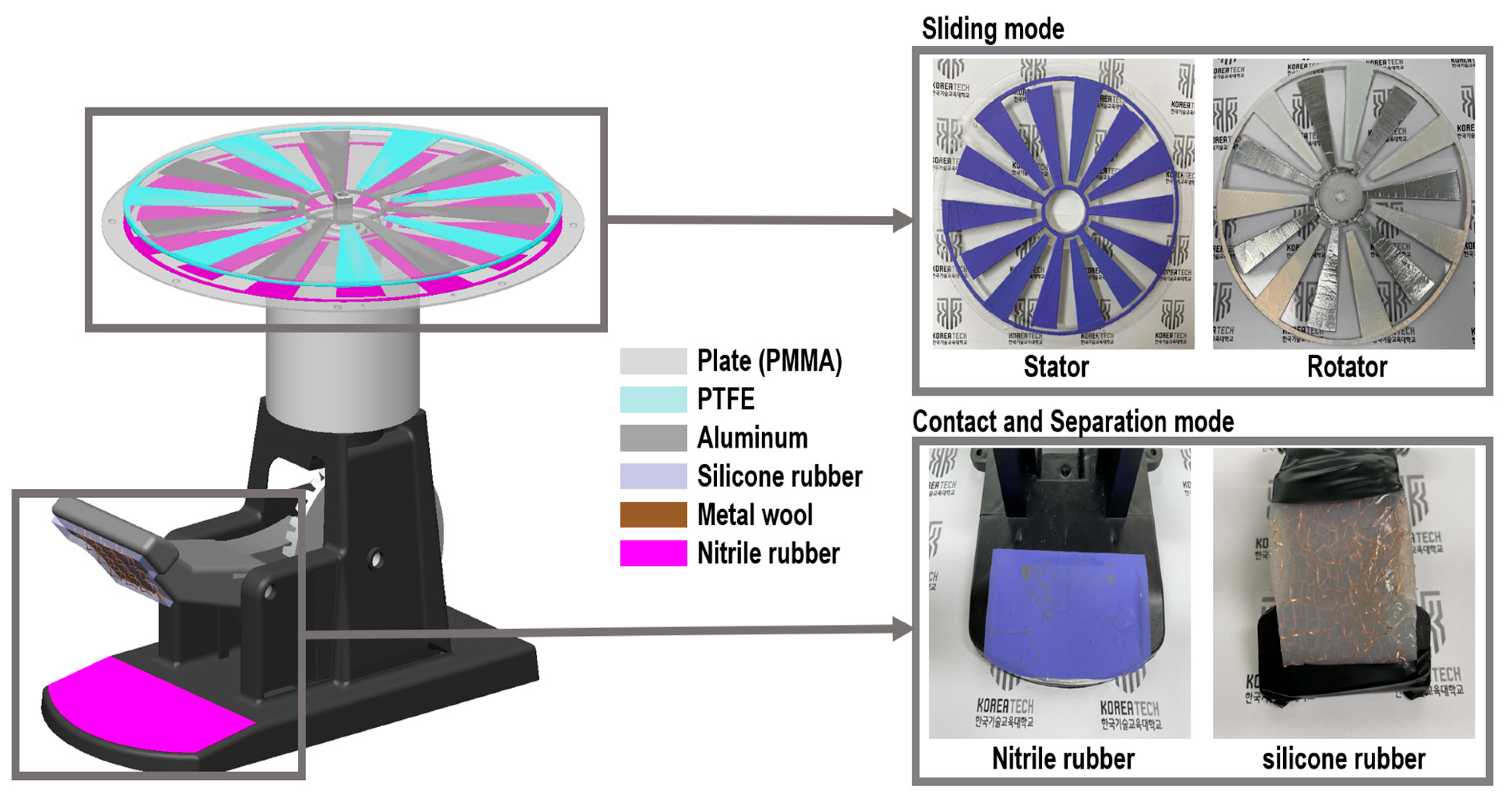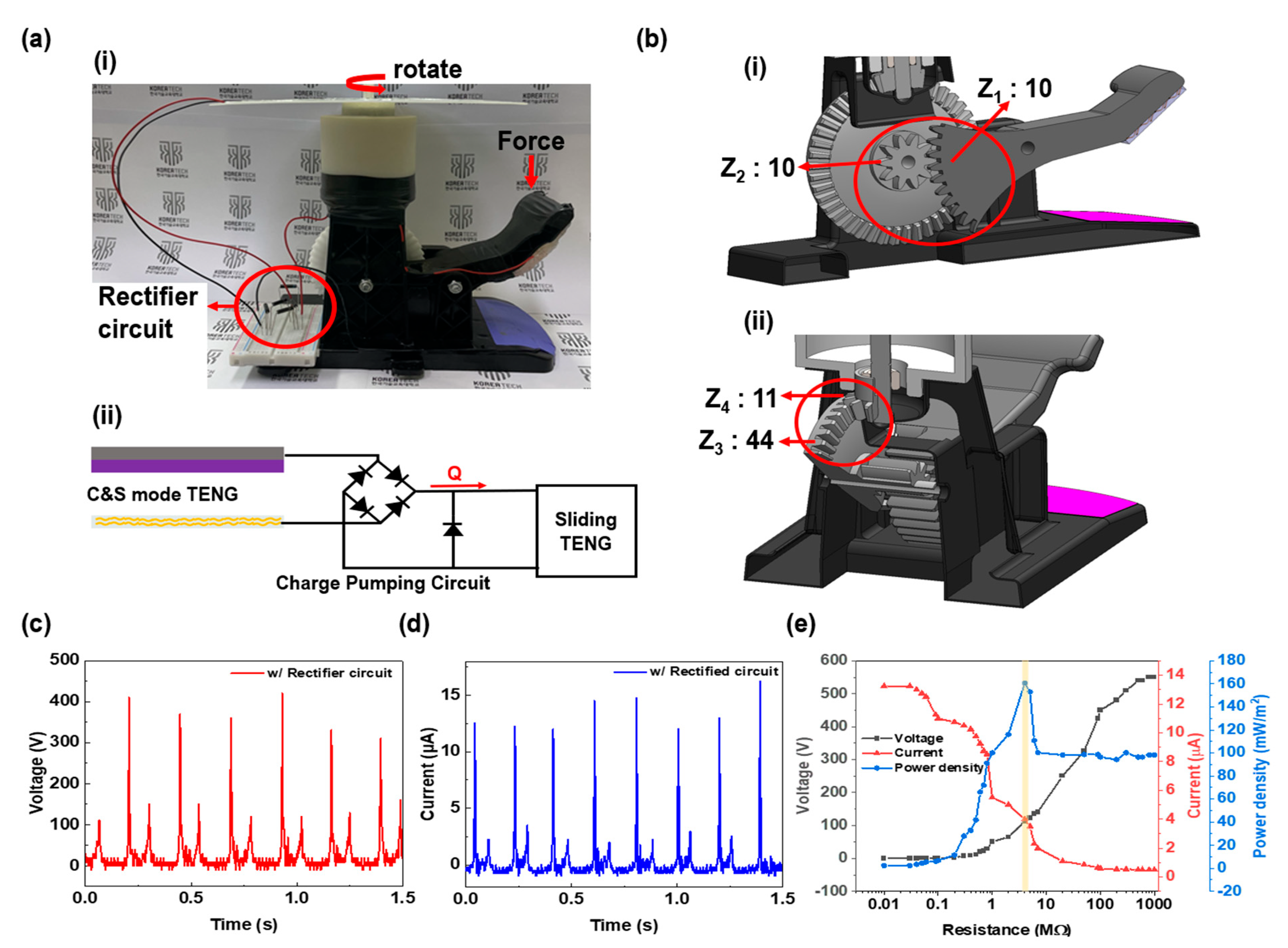Efficient Long-Lasting Energy Generation Using a Linear-to-Rotary Conversion Triboelectric Nanogenerator
Abstract
:1. Introduction
2. Materials and Methods
2.1. Fabrication Process of the Triboelectric Nanogenerator (TENG) Device
2.2. Evaluation of LRC-TENG
3. Device Design
3.1. Parts of the Charge Pumping
3.2. Mechanical Parts
4. Linear-to-Rotary Conversion Triboelectric Nanogenerator (LRC-TENG)
4.1. Parameter Design
4.2. Output Performance and Applications
5. Conclusions
Supplementary Materials
Author Contributions
Funding
Data Availability Statement
Conflicts of Interest
References
- Wang, J.; Zi, Y.; Li, S.; Chen, X. High-voltage applications of the triboelectric nanogenerator—Opportunities brought by the unique energy technology. MRS Energy Sustain. 2020, 6, E17. [Google Scholar] [CrossRef]
- Wang, A.C.; Wu, C.; Pisignano, D.; Wang, Z.L.; Persano, L. Polymer nanogenerators: Opportunities and challenges for large-scale applications. J. Appl. Polym. Sci. 2018, 135, 45674. [Google Scholar] [CrossRef]
- Fan, F.R.; Tian, Z.Q.; Wang, Z.L. Flexible triboelectric generator. Nano Energy 2012, 1, 1328–1334. [Google Scholar] [CrossRef]
- Wu, C.; Wang, A.C.; Ding, W.; Guo, H.; Wang, Z.L. Triboelectric nanogenerator: A foundation of the energy for the new era. Adv. Energy Mater. 2019, 9, 1802906. [Google Scholar] [CrossRef]
- Furfari, F.A. A history of the Van de Graaff generator. IEEE Ind. Appl. Mag. 2005, 11, 10–14. [Google Scholar] [CrossRef]
- Wang, Z.L.; Chen, J.; Lin, L. Progress in triboelectric nanogenerators as a new energy technology and self-powered sensors. Energy Environ. Sci. 2015, 8, 2250–2282. [Google Scholar] [CrossRef]
- Niu, S.; Wang, S.; Lin, L.; Liu, Y.; Zhou, Y.S.; Hu, Y.; Wang, Z.L. Theoretical study of contact-mode triboelectric nanogenerators as an effective power source. Energy Environ. Sci. 2013, 6, 3576. [Google Scholar] [CrossRef]
- Wang, Z.L.; Wang, A.C. On the origin of contact-electrification. Mater. Today 2019, 30, 34–51. [Google Scholar] [CrossRef]
- Choi, Y.S.; Kim, S.W.; Kar-Narayan, S. Materials-related strategies for highly efficient triboelectric energy generators. Adv. Energy Mater. 2021, 11, 2003802. [Google Scholar] [CrossRef]
- Lin, L.; Xie, Y.; Niu, S.; Wang, S.; Yang, P.K.; Wang, Z.L. Robust triboelectric nanogenerator based on rolling electrification and electrostatic induction at an instantaneous energy conversion efficiency of ~55%. ACS Nano 2015, 9, 922–930. [Google Scholar] [CrossRef]
- Bhatia, D.; Hwang, H.J.; Huynh, N.D.; Lee, S.; Lee, C.; Nam, Y.; Kim, J.G.; Choi, D. Continuous scavenging of broadband vibrations via omnipotent tandem triboelectric nanogenerators with cascade impact structure. Sci. Rep. 2019, 9, 8223. [Google Scholar] [CrossRef] [PubMed]
- Hwang, H.J.; Jung, Y.; Choi, K.; Kim, D.; Park, J.; Choi, D. Comb-structured triboelectric nanogenerators for multi-directional energy scavenging from human movements. Sci. Technol. Adv. Mater. 2019, 20, 725–732. [Google Scholar] [CrossRef] [PubMed]
- Yong, H.; Chung, J.; Choi, D.; Jung, D.; Cho, M.; Lee, S. Highly reliable wind-rolling triboelectric nanogenerator operating in a wide wind speed range. Sci. Rep. 2016, 6, 33977. [Google Scholar] [CrossRef] [PubMed]
- Ren, Z.; Wang, Z.; Liu, Z.; Wang, L.; Guo, H.; Li, L.; Li, S.; Chen, X.; Tang, W.; Wang, Z.L. Energy harvesting from breeze wind (0.7–6 m/s) using ultra-stretchable triboelectric nanogenerator. Adv. Energy Mater. 2020, 10, 2001770. [Google Scholar] [CrossRef]
- Zhang, X.; Hu, J.; Yang, Q.; Yang, H.; Yang, H.; Li, Q.; Li, X.; Hu, C.; Xi, Y.; Wang, Z.L. Harvesting multidirectional breeze energy and self-powered intelligent fire detection systems based on triboelectric nanogenerator and fluid-dynamic modeling. Adv. Funct. Mater. 2021, 31, 2106527. [Google Scholar] [CrossRef]
- Long, L.; Liu, W.; Wang, Z.; He, W.; Li, G.; Tang, Q.; Guo, H.; Pu, X.; Liu, Y.; Hu, C. High performance floating self-excited sliding triboelectric nanogenerator for micro mechanical energy harvesting. Nat. Commun. 2021, 12, 4689. [Google Scholar] [CrossRef]
- Chen, J.; Guo, H.; Hu, C.; Wang, Z.L. Robust triboelectric nanogenerator achieved by centrifugal force induced automatic working mode transition. Adv. Energy Mater. 2020, 10, 2000886. [Google Scholar] [CrossRef]
- Li, Q.; Liu, W.; Yang, H.; He, W.; Long, L.; Wu, M.; Zhang, X.; Xi, Y.; Hu, C.; Wang, Z.L. Ultra-stability high-voltage triboelectric nanogenerator designed by ternary dielectric triboelectrification with partial soft-contact and non-contact mode. Nano Energy 2021, 90, 106585. [Google Scholar] [CrossRef]
- Wang, J.; Ding, W.; Pan, L.; Wu, C.; Yu, H.; Yang, L.; Liao, R.; Wang, Z.L. Self-powered wind sensor system for detecting wind speed and direction based on a triboelectric nanogenerator. ACS Nano 2018, 12, 3954–3963. [Google Scholar] [CrossRef]
- Xu, L.; Bu, T.Z.; Yang, X.D.; Zhang, C.; Wang, Z.L. Ultrahigh charge density realized by charge pumping at ambient conditions for triboelectric nanogenerators. Nano Energy 2018, 49, 625–633. [Google Scholar] [CrossRef]
- Cheng, L.; Xu, Q.; Zheng, Y.; Jia, X.; Qin, Y. A self-improving triboelectric nanogenerator with improved charge density and increased charge accumulation speed. Nat. Commun. 2018, 9, 3773. [Google Scholar] [CrossRef] [PubMed]
- Liu, W.; Wang, Z.; Wang, G.; Liu, G.; Chen, J.; Pu, X.; Xi, Y.; Wang, X.; Guo, H.; Hu, C. Integrated charge excitation triboelectric nanogenerator. Nat. Commun. 2019, 10, 1426. [Google Scholar] [CrossRef] [PubMed]
- Ma, J.; Youn, J.H.; Cho, H.; Park, J.; Kyung, K.U. Highly efficient long-lasting triboelectric nanogenerator upon impact and its application to daily-life self-cleaning solar panel. Nano Energy 2022, 103, 107836. [Google Scholar] [CrossRef]
- Wu, J.; Teng, X.; Liu, L.; Cui, H.; Li, X. Eutectogel-based self-powered wearable sensor for health monitoring in harsh environments. Nano Res. 2024, 17, 5559–5568. [Google Scholar] [CrossRef]
- He, J.; Guo, X.; Pan, C.; Cheng, G.; Zheng, M.; Zi, Y.; Li, X. High-output soft-contact fiber-structure triboelectric nanogenerator and its sterilization application. Nanotechnology 2023, 34, 385403. [Google Scholar] [CrossRef]
- Guo, X.; He, J.; Zheng, Y.; Wu, J.; Pan, C.; Zi, Y.; Li, X. High-performance triboelectric nanogenerator based on theoretical analysis and ferroelectric nanocomposites and its high-voltage applications. Nano Res. Energy 2023, 2, 3. [Google Scholar] [CrossRef]
- Niu, S.; Liu, Y.; Chen, X.; Wang, S.; Zhou, Y.S.; Lin, L.; Xie, Y.; Wang, Z.L. Theory of freestanding triboelectric-layer-based nanogenerators. Nano Energy 2015, 12, 760–774. [Google Scholar] [CrossRef]
- Bai, P.; Zhu, G.; Liu, Y.; Chen, J.; Jing, Q.; Yang, W.; Wang, Z.L. Cylindrical rotating triboelectric nanogenerator. ACS Nano 2013, 7, 6361–6366. [Google Scholar] [CrossRef]
- Niu, S.; Liu, Y.; Wang, S.; Lin, L.; Zhou, Y.S.; Hu, Y.; Wang, Z.L. Theory of Sliding-Mode Triboelectric Nanogenerators. Adv. Mater. 2013, 25, 6184–6193. [Google Scholar] [CrossRef]
- Shin, J.; Ji, S.; Cho, H.; Park, J. Highly flexible triboelectric nanogenerator using porous carbon nanotube composites. Polymers 2023, 15, 1135. [Google Scholar] [CrossRef]
- Shin, J.; Ji, S.; Yoon, J.; Park, J. Module-type triboelectric nanogenerators capable of harvesting power from a variety of mechanical energy sources. Micromachines 2021, 12, 1043. [Google Scholar] [CrossRef] [PubMed]
- Kamilya, T.; Han, D.; Shin, J.; Kwon, S.; Park, J. An Ultrasensitive Laser-Induced Graphene Electrode-Based Triboelectric Sensor Utilizing Trapped Air as Effective Dielectric Layer. Polymers 2024, 16, 26. [Google Scholar] [CrossRef] [PubMed]
- Kalinowski, J. Electroluminescence in organics. J. Phys. D Appl. Phys. 1999, 32, R179. [Google Scholar] [CrossRef]
- Mitschke, U.; Bäuerle, P. The electroluminescence of organic materials. J. Mater. Chem. 2000, 10, 1471–1507. [Google Scholar] [CrossRef]






| Symbol | Name | Quantity | Unit |
|---|---|---|---|
| PTFE Relative permittivity | 2.0 | ||
| Ground | 0 (Al) | ||
| V | Terminal voltage | 500, 700 |
Disclaimer/Publisher’s Note: The statements, opinions and data contained in all publications are solely those of the individual author(s) and contributor(s) and not of MDPI and/or the editor(s). MDPI and/or the editor(s) disclaim responsibility for any injury to people or property resulting from any ideas, methods, instructions or products referred to in the content. |
© 2024 by the authors. Licensee MDPI, Basel, Switzerland. This article is an open access article distributed under the terms and conditions of the Creative Commons Attribution (CC BY) license (https://creativecommons.org/licenses/by/4.0/).
Share and Cite
Shin, J.; Ji, S.; Yoon, J.; Kim, D.H.; Park, J. Efficient Long-Lasting Energy Generation Using a Linear-to-Rotary Conversion Triboelectric Nanogenerator. Actuators 2024, 13, 396. https://doi.org/10.3390/act13100396
Shin J, Ji S, Yoon J, Kim DH, Park J. Efficient Long-Lasting Energy Generation Using a Linear-to-Rotary Conversion Triboelectric Nanogenerator. Actuators. 2024; 13(10):396. https://doi.org/10.3390/act13100396
Chicago/Turabian StyleShin, Jaehee, Sungho Ji, Jiyoung Yoon, Duck Hwan Kim, and Jinhyoung Park. 2024. "Efficient Long-Lasting Energy Generation Using a Linear-to-Rotary Conversion Triboelectric Nanogenerator" Actuators 13, no. 10: 396. https://doi.org/10.3390/act13100396







